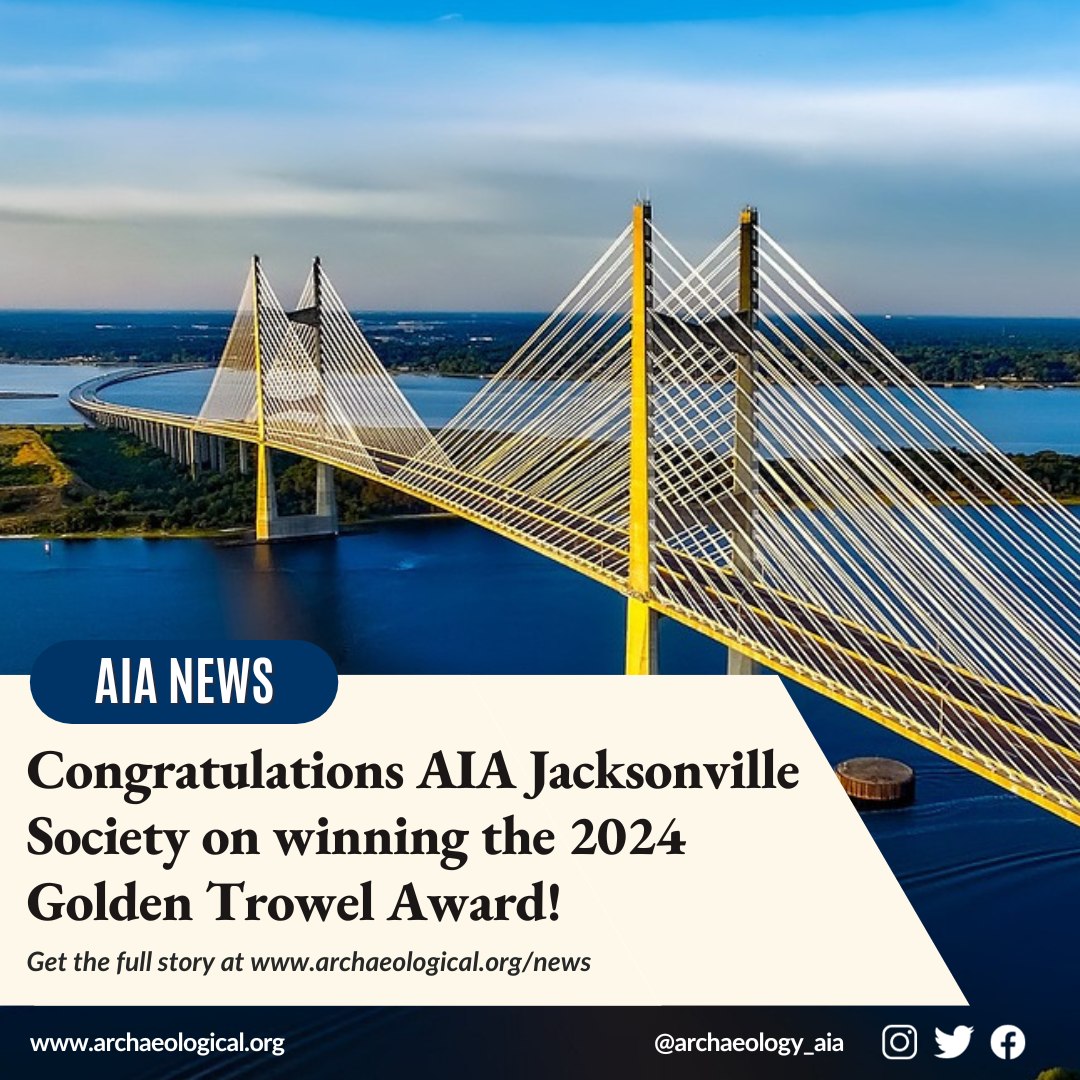The Archaeological Institute of America - Jacksonville Society
The Archaeological Institute of America (AIA) is the world's oldest and largest archaeological organization. The AIA is a nonprofit founded in 1879 and chartered by the United States Congress in 1906. There are more than 100 local societies, like this Jacksonville Society, in the United States, Canada, and overseas. Members include professional archaeologists, students, and enthusiasts, all united by their passion for archaeology and its role in furthering human knowledge.
The AIA promotes archaeological inquiry and public understanding of the material record of the human past to foster an appreciation of diverse cultures and our shared humanity.
The AIA supports archaeologists, their research and its dissemination, and the ethical practice of archaeology.
The AIA educates people of all ages about the significance of archaeological discovery and advocates for the preservation of the world’s archaeological heritage.
Professional archaeologists who are AIA members, have conducted fieldwork worldwide. The Institute has founded research centers and schools in seven countries and maintains close contact with these institutions. AIA Members are dedicated to the greater understanding of archaeology, the protection and preservation of the world's archaeological resources, and the support of archaeological research and publication.
___________________________________________________________________________________________________________________________________________________
SEASONAL LECTURES
Our speaker presentations take place at noon, in Building 51 at the University of North Florida, Jacksonville, (1 UNF Dr, Jacksonville, FL 32224). Email [email protected] to find out if Zoom is offered for each lecture. The lectures are free and open to the public. After the lecture, complimentary refreshments may be served in the Physical Anthropology Lab. On Saturdays, parking is free and the staff/faculty/vendor spaces are open to everyone.
2024 MEETINGS & PRESENTATIONS
Alex Diaz, Master Student, Florida State University
Crafting Bones: An Analysis of a Worked Bone Assemblage from a Mississippian Mound Complex in Northeast Florida
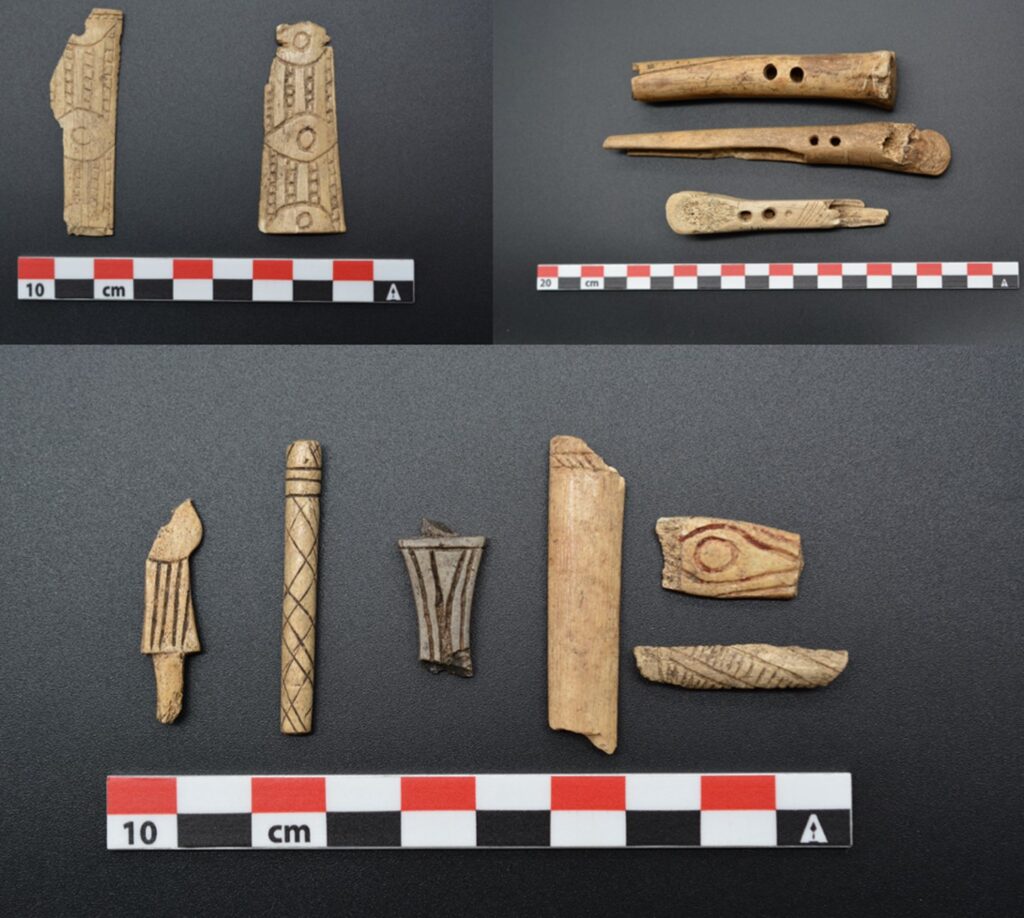
Bone has been used as a medium for crafting both tools and decorative items since our earliest ancestors; however, this important component of material culture has often been overlooked. The analysis of the worked bone assemblage recovered from the excavations at the Mill Cove Complex has the potential to provide insights into the role of worked bone within a unique ritual context. Diaz worked to create a typology using a multi-analytical approach to highlight the relationships between form and function supported by use-wear and macro fracture analysis to provide insights into the manufacturing, use, and discard of the worked bone artifacts recovered from the site. The data gathered from this study has contributed to a better understanding of the role worked bone played within ritual contexts among the pre-contact communities along Florida’s Northeast coast.
Dr. Tate Paulette from North Carolina State University
When Beer Flowed Like Wine: Beer and Brewing in Bronze Age Mesopotamia
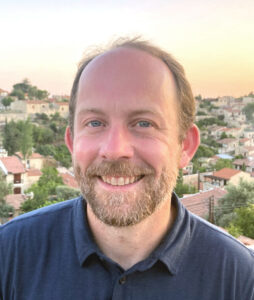 We may be living in the age of craft brewing, but the craft of brewing has much deeper roots. For thousands of years, people have been intentionally fermenting cereal grains to create their own unique versions of the intoxicating beverage that we now call beer. In ancient Mesopotamia, beer was produced on a massive scale and was consumed on a daily basis by people across the socio-economic spectrum. Beer was a gift from the gods, a marker of civilization, a dietary staple, a social lubricant, a ritual necessity, and a reason for celebration. It was consumed at feasts, festivals, and ritual ceremonies, but also at home, on the job, and in neighborhood taverns. It was produced by brewers working for the powerful palace and temple institutions and also by local tavern keepers and homebrewers. This lecture explores the archaeological, artistic, and written evidence for beer and brewing in Bronze Age (3000–1200 BC) Mesopotamia, as well as recent efforts to recreate Mesopotamian beer.
We may be living in the age of craft brewing, but the craft of brewing has much deeper roots. For thousands of years, people have been intentionally fermenting cereal grains to create their own unique versions of the intoxicating beverage that we now call beer. In ancient Mesopotamia, beer was produced on a massive scale and was consumed on a daily basis by people across the socio-economic spectrum. Beer was a gift from the gods, a marker of civilization, a dietary staple, a social lubricant, a ritual necessity, and a reason for celebration. It was consumed at feasts, festivals, and ritual ceremonies, but also at home, on the job, and in neighborhood taverns. It was produced by brewers working for the powerful palace and temple institutions and also by local tavern keepers and homebrewers. This lecture explores the archaeological, artistic, and written evidence for beer and brewing in Bronze Age (3000–1200 BC) Mesopotamia, as well as recent efforts to recreate Mesopotamian beer.
Dr. Tate Paulette studies urban food systems in the ancient world. A native of North Carolina, he holds an MA and PhD in Near Eastern Archaeology from the University of Chicago and an MA in Archaeology from the University of Edinburgh. His research explores agricultural practices, gastro-politics, and state making in the world’s first cities and states, with a focus on Mesopotamia and the Near East. He also studies ancient alcohol, and he has spearheaded a collaborative effort to recreate Sumerian beer using authentic ingredients, equipment, and brewing techniques.
Dr. Sarah Freidline, University of Central Florida
Recent advances in human origins research: new insights from Northern Africa to Southeast Asia
 New technologies and methodological approaches in the last decades have led to exciting advances in paleoanthropology—especially concerning the origin of our species, dated to roughly 300,000 years ago, and our subsequent dispersions out of Africa. Current fossil and genomic data suggest that we were not the only members of our genus alive during this time. In this talk, I will discuss recent advances and pending questions in human origins research, focusing on my work on some of the earliest Homo sapiens fossils from Northern Africa (Jebel Irhoud, Morocco) and Southeast Asia (Tam Pà Ling, Laos), as well as our enigmatic cousins, the Denisovans.
New technologies and methodological approaches in the last decades have led to exciting advances in paleoanthropology—especially concerning the origin of our species, dated to roughly 300,000 years ago, and our subsequent dispersions out of Africa. Current fossil and genomic data suggest that we were not the only members of our genus alive during this time. In this talk, I will discuss recent advances and pending questions in human origins research, focusing on my work on some of the earliest Homo sapiens fossils from Northern Africa (Jebel Irhoud, Morocco) and Southeast Asia (Tam Pà Ling, Laos), as well as our enigmatic cousins, the Denisovans.
Dr. Freidline is a biological anthropologist who specializes in paleoanthropology. Her research focuses on the evolution and development of human craniofacial morphology. She applies state-of-the-art methods to interpret craniofacial growth in fossil species ranging from Homo erectus to H. neanderthalensis and H. sapiens with the ultimate goal of better understanding the evolution of the H. sapiens face. Freidline combines geometric morphometric methods and surface histology to quantify macro and microscopic shape changes. Furthermore, as fossil bones are nearly always damaged, a large part of her work consists of virtual fossil reconstruction.
Sarah received her Ph.D. in 2012 working jointly at the City University of New York (CUNY) Graduate Center and the Max Plank Institute for Evolutionary Anthropology (MPI-EVA) in Leipzig, Germany. From 2012 to 2020, she worked as a post-doctoral researcher at the MPI-EVA in the Department of Human Evolution.
Dr. Charles Cobb from the Florida Museum of Natural History at the University of Florida
Following the Metal Wake of Spanish Expeditions in the Southeast
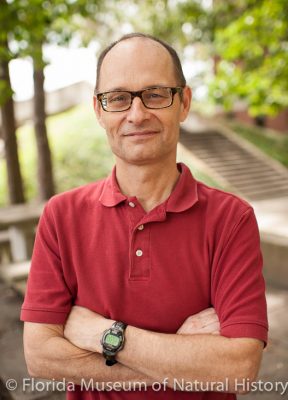 Many of the artifacts from 16th-century Spanish explorations found on Native American sites in the American Southeast have been documented from burial contexts. This has given rise to the received wisdom that these objects were usually gifts distributed to Indigenous elites. Over the past decade, archaeological research at sites in Mississippi, Alabama, and Georgia has challenged this perspective. Systematic-metal detecting surveys have revealed that objects of European origin are far more abundant than previously realized and are often found in domestic contexts. This work is opening up new interpretations about how Native Americans acquired European goods, as well as how they modified these objects in ways that aligned with Indigenous worldviews.
Many of the artifacts from 16th-century Spanish explorations found on Native American sites in the American Southeast have been documented from burial contexts. This has given rise to the received wisdom that these objects were usually gifts distributed to Indigenous elites. Over the past decade, archaeological research at sites in Mississippi, Alabama, and Georgia has challenged this perspective. Systematic-metal detecting surveys have revealed that objects of European origin are far more abundant than previously realized and are often found in domestic contexts. This work is opening up new interpretations about how Native Americans acquired European goods, as well as how they modified these objects in ways that aligned with Indigenous worldviews.
Charles Cobb has been the Curator of Historical Archaeology at the Florida Museum of Natural History since 2014. He also is Director of the Museum’s Randell Research Center located on Pine Island in southwest Florida. He received his PhD in 1988 from Southern Illinois University and was subsequently a faculty member in anthropology at SUNY-Binghamton and University of South Carolina before his arrival at the University of Florida. Cobb has a long-term interest in the history and archaeology of Indigenous cultures of the southeastern United States, with a particular focus on interactions between Native Americans and European colonials. Since his arrival at Florida, he has been developing an online digital database of Florida Museum artifact collections from St. Augustine and Franciscan mission sites. Meanwhile, his field projects have had two emphases: first, addressing the impacts of Spanish expeditions on Native American societies during the 1500s A.D.; second, investigating the widespread abandonment of Indigenous towns in the mid-South during the 1400s A.D. Since 2015, his fieldwork has been carried out in collaboration with the Chickasaw Nation.
MAKE A DONATION
A donation of any amount helps us with speaker presentations. Just click the secure “DONATE” button below to use your credit card or PayPal account.
All of us enjoy the speakers and presentations that showcase the fascinating scope of archaeology in these exciting times of discovery and technological change. Your gift assists with expenses incurred by the visiting scholars and archaeologists at our events.
Thank you for your consideration and support!

AIA MEMBERSHIP
Join the Archaeological Institute of America, the world’s largest and oldest archaeological organization today, and be connected with thousands of other members who share your passion for archaeology!
Connect with thousands of members who share your passion for archaeology.
Participate in local events through an AIA Local Society.
Receive exclusive MEMBER BENEFITS.
Members like you support excavation, preservation, outreach, education, advocacy, and the professional activities of the AIA.
RECENT ARCHAEOLOGY NEWS
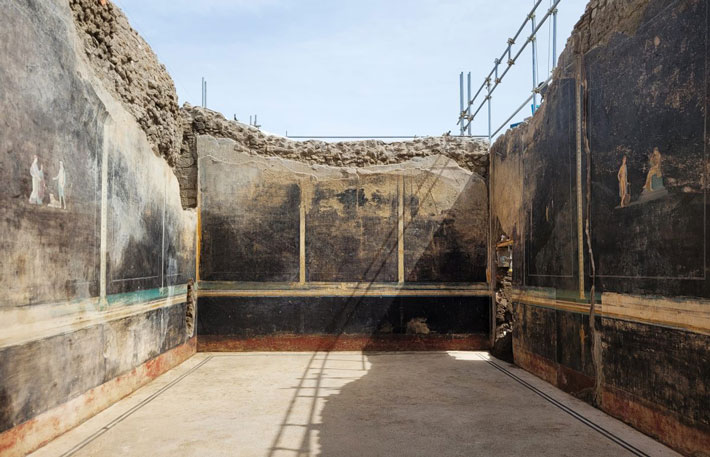 Frescoed Dining Hall Discovered in Pompeii
Frescoed Dining Hall Discovered in Pompeii
NAPLES, ITALY—According to a BBC News report, a large banqueting hall with frescoed walls and a white mosaic floor has been unearthed in Regio IX of Pompeii, a Roman city destroyed by the eruption of Mount Vesuvius in A.D. 79. Gabriel Zuchtriegel, director of the Pompeii Archaeological Park, said that the paintings were placed on a black background, which may have been chosen to hide smoke deposits from burning lamps. “In the shimmering light, the paintings would have almost come to life,” he added. The room features two paintings of mythic Greek figures: the first depicts the Trojan priestess Cassandra with the god Apollo, who gave her the gift of prophecy, but then cursed her when she rejected his romantic advances so that her prophecies, although true, would not be believed. She predicted that if the Trojan prince Paris went to Sparta and returned with Helen, the Queen of Sparta, it would result in the destruction of Troy. Paris ignored the prophecy, and the second painting shows his doomed meeting with the beautiful Helen. This so-called “black room” was found in the same structure where a bakery that likely operated using the labor of enslaved workers was found. Construction supplies have also been uncovered in the reception hall. Inscriptions found in the building indicate it belonged to Aulus Rustius Verus. “We know him from other political propaganda in Pompeii," said archaeologist Sophie Hay. "He’s a politician. He’s super-rich." To read about another painting recently found in Pompeii, go to "Pizza! Pizza?"
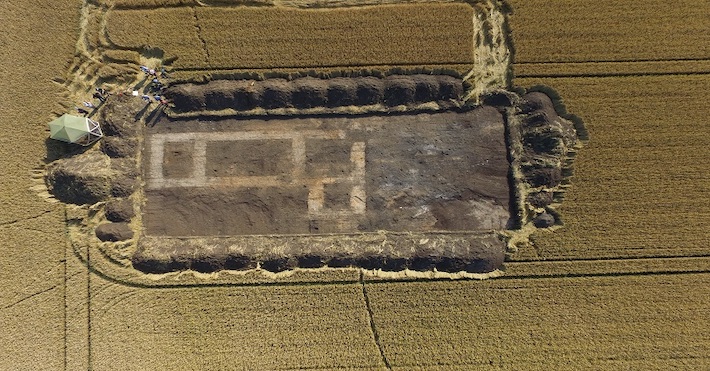
Earthwork Henge Discovered in Eastern England
LINCOLNSHIRE, ENGLAND—Newsweek reports that an earthwork henge measuring nearly 250 feet across has been discovered in eastern England, on what was once a peninsula surrounded on three sides by water and marshes. Smaller henges have been found in the region, indicating that this one may have been a hub for ceremonial activity, according to Duncan Wright of Newcastle University and Hugh Willmott of the University of Sheffield. Based upon information in a medieval text, the researchers had been looking for a hermitage built by an Anglo-Saxon monk on a plundered burial mound when they found the earthwork. “In prehistoric times the henge would have formed a large circular enclosed space, with a huge bank and ditch running around the outside. It may have had one or more burial mounds built inside it during the Bronze Age,” Wright said. The excavation also uncovered pottery, two bone combs, fragments of a glass drinking vessel dated to the eighth century, and traces of an abbey hall and chapel later built on the site in the twelfth century. Read the original scholarly article about this research in Journal of Field Archaeology. To read about another henge monumen in England, go to "Stonehenge's New Neighbor."
READ MORE RECENT ARCHAEOLOGY NEWS
CURRENT ARCHAEOLOGY MAGAZINE
Click the cover image for more details

Searching for Lost Cities
From Iraq to West Africa and the English Channel to the Black Sea, archaeologists are on the hunt for evidence of once-great cities lost to time
Alexander the Great's Untold Story
Excavations in northern Greece are revealing the world that shaped the future king
Emblem for a New Era
A Bronze Age warrior’s grave yields a final clue to his identity
Forts of the Bison Hunters
How the Wichita secured their homeland on the Great Plains
High Priestesses of Copper Age Spain
Opulent burials are evidence of women’s religious and political power nearly 5,000 years ago


